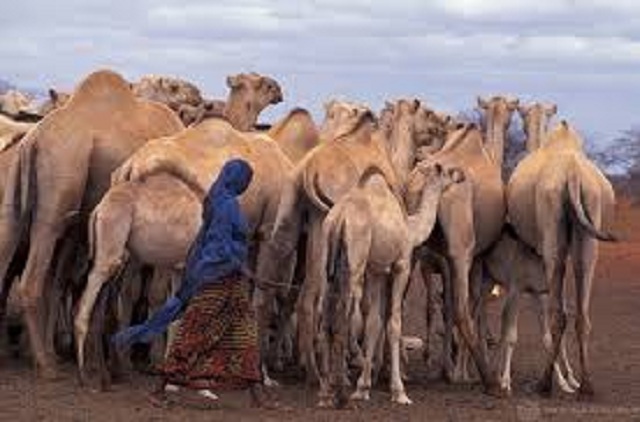Kenya in a froth as drought spurs switch to ‘camelcinos’

Hannah McNeish
ISIOLO, Kenya – It took 70 dairy cows dying from repeated droughts to convince Fatuma Yousef to try a new business model: camels.
As increasingly fierce, frequent and lengthy dry spells hit northern Kenya, raising dairy cattle has gotten ever harder.
But after seeing her initial five camels thrive while eating just tree branches and leaves, Yousef sold 100 cows to buy more expensive camels, whose milk now never dries up.
Now she owns 60 of the beasts, something she considers a good investment as climate change brings more extreme weather. And as more camel milk comes on the market, “camelcinos” are cropping up in Nairobi’s cafes, alongside the usual cappuccinos.
“Camels are the number one thing round here right now,” said Yousef, waiting at a camel milk collection centre in the northern town of Isiolo, amid her collection of heavy yellow jerry cans.
“The cows can’t cope with the drought,” she added. But now she produces 60 litres of camel milk a day, from about 20 long-legged “milkers”.
More extreme weather in Kenya’s arid and neglected northern rangelands – and surging demand for cattle milk in Kenya’s cities – are leading growing numbers of the region’s nomadic herders to see camels as a drought-safe business investment.
That’s led to what people in Isiolo call a “camel rush,” as demand outstrips supply. Prices for both the milk and the camels that produce it are on the rise, with a good milk camel going for between $400 and $1,000 in the region.
“I get more for my camel milk,” explained Yousef, above the din of dozens of women getting their camel milk tested for impurities and doing business on their phone or chatting to friends. “I used to get 60 shillings ($0.60) per litre (for cow’s milk). Now I get 110 shillings ($1.10).”
Piers Simpkin, a camel expert who has studied them for over 30 years and runs his own milking business in Elmenteita, about 130km from the capital, said that he has seen “a huge change in the range of camel keeping” in recent years.
Herds are growing fastest among the Maasai tribe in southern Kenya, where people have traditionally only kept cows, he said, but are growing in other places as well.
“I think we’ll be seeing an increase in camel milk consumption with climate change,” said Simpkin. “Drier conditions and global warming are better suited to camel production.”
POUR ME A “CAMELCINO”
With 60 percent of the world’s camels, East Africa produces most of the world’s camel milk, almost all of which is consumed domestically.
Demand for the milk in the capital Nairobi – where cafes in the bustling business district serve “camelcinos” (a cappuccino made with camel milk) – is so high that it has spawned a booming camel milk industry in the neighbouring Kajiado county.
Further north, the surge in camel herding is coming as families watch a warming world turn grasslands to dust and bring a traditional livestock industry to its knees.
“Drought can kill between 50 and 80 percent of cattle herds,” said Simpkin. “At the same time, you’ll probably only get a 10 to16 percent mortality in camel herds.”
He has been training herders on the best camel milking practices in the counties of Samburu and Turkana for years, he said. A camel there, he said, can produce four to five times the volume of milk as a local cow.
While demand for camel milk is growing, the supply of quality product is still low. In Kenya, yearly production is estimated at around 1 million metric tonnes, worth about 54 billion shillings, or $534 million.
But a lack of government interest or investment in camel milk, which is still not recognised under Kenya’s dairy act, has hampered efforts to create industry standards or an export market.
“The demand is so large locally, there probably won’t be enough for export”, said Simpkin. “I could sell 10 times as much in the local town nearest to where I’m producing the milk,” he added.
Camel milk producers in Isiolo 10,000 litres of milk a month to Holger Marbach’s Vital Camel Milk factory in Nanyuki, about an hour away.
“I estimate demand is probably double,” Marbach said.
Kenya today has triple the number of camels it did in 2005 – when Marbach started his business – or around 3 million, with the surge largely a response to unpredictable weather patterns.
“The weather has seriously changed – the rains are no longer predictable,” he said.
COLD MILK, HOT BUSINESS
Since 2007, Dutch development agency SNV has been working with women in Isiolo to try to commercialise the local camel milk industry and boost communities’ resilience to climate change.
SNV and partners helped around 100 women form a camel milk cooperative in 2010. Using about $200,000 in donor money, they built freezers to chill milk, installed a 3,000-litre cooling tank and set up milk testing equipment.
Livestock specialists have also trained women in nearby communities on milking hygiene and camel-keeping, and linked them to nearby markets to get better prices.
The cooperative has increased its production six fold from 2008 – and now produces 3,000 litres of camel milk a day.
The women’s profits also have increased by a third since 2014, even as operating costs have dropped by more than 40 percent.
“For a minimal amount of investment, it seems that by linking high-demand urban areas with drought-prone rural areas, we can help communities adapt to a changing climate,” said Brian Harding, SNV’s climate change specialist. — Thomson Reuters Foundation











Comments